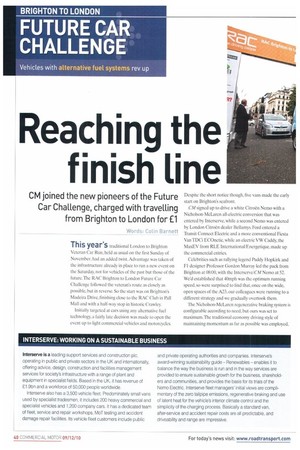Reaching the finish line
Page 40

Page 41

If you've noticed an error in this article please click here to report it so we can fix it.
CM joined the new pioneers of the Future Car Challenge, charged with travelling from Brighton to London for El
Words: Cohn Barnett
This year's traditional London to Brighton Veteran Car Run, held as usual on the first Sunday of November, had an added twist. Advantage was taken of the infrastructure already in place to run a new event on the Saturday, not for vehicles of the past but those of the future. The RAC Brighton to London Future Car Challenge followed the veteran's route as closely as possible, but in reverse. So the start was on Brighton's Madeira Drive, finishing close to the RAC Club in Pall Mall and with a half-way stop in historic Crawley.
Initially targeted at cars using any alternative fuel technology, a fairly late decision was made to open thc event up to light commercial vehicles and motorcycles. Despite the short notice though, five vans made the early start on Brighton's seafront.
CM signed up to drive a white Citrodn Nemo with a Nicholson-McLaren all-electric conversion that was entered by Interserve, while a second Nemo was entered by London Citroen dealer Bellamys. Ford entered a Transit Connect Electric and a more conventional Fiesta Van TDCi ECOnetic. while an electric VW Caddy, the MaxEV from RLE International/Energetique. made up the commercial entries.
Celebrities such as rallying legend Paddy Hopkirk and Fl designer Professor Gordon Murray led the pack from Brighton at 08:00, with the Interserve/CM Nemo at 52. We'd established that 40mph was the optimum running speed, so were surprised tolind that, once on the wide, open spaces of the A23, our colleagues were running to a different strategy and we gradually overtook them.
The Nicholson-McLaren regenerative braking system is configurable according to need, but ours was set to maximum.The traditional economy driving style of maintaining momentum as far as possible was employed, but when a stop in traffic became inevitable, the technique used was to lift off the throttle pedal as late as possible, providing maximum regeneration. As a result, use of the footbrake was practically non-existent; indeed, its use was seen as a failure. With practice, the technique was mastered, and it came in very useful in the later stages in the Saturday morning London traffic.
Even with the start brought forward, the traffic beyond Croydon was ver■,, heavy, and soon turned into a meaningless stop-start battle. Good directions transmitted by our co-driver, lnterserve's transport guru David Balderson, meant we arrived at Pall Mall with no wrong turns.
Results were calculated by a team of boffins from Imperial College from a comprehensive on-board telematics system. Apart from the predictable traffic issues reducing our average speed to that of horse-drawn days, the event's only real shortcoming was the results. Many entrants were reticent about having numbers published, so at the awards ceremony in Regent Street, only the names of the class winners were revealed — and sadly our class was won by the Bellamys van. It took more than a week to discover how closely we'd been beaten. As you can see from the table, our consumption figures were identical, only a slightly better regeneration performance giving the red van an advantage of just 0.004kWihr. However, as our journey time was 15 minutes faster, we claim an unofficial, moral productivity victory.
Based on the best domestic tariff found of 7p/kWh, both vans did the 57-mile trip for well under £1, and in our case, using 80% of a full charge. Regardless of the issues of the true CO2 cost of electricity. the event proves that battery power is becoming a viable fuel for certain operations, especially for urban return-to-base (or driver's home) routines with predictable journey patterns. •
























































































































